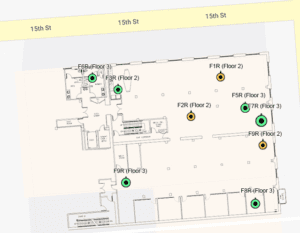Organizations and workers in energy, mining, utilities, construction, and manufacturing deal with specialized, complex, and potentially dangerous equipment and materials that require vigilance, adherence to standard operating procedures, and proper training to ensure the safety of themselves and others.
The nature of these industries makes them inherently perilous and compliance-centric for workers, and competitive organizations know how critical it is to enable, document, and operate a safe workplace.


Digital transformation unlocks the opportunity for organizations in heavy industries to strengthen worker safety and compliance by reducing human error, enhancing safety protocols, and automating responses to incidents. Collaboration tools connect teams, but they also reinforce safe work practices, help in incident response, and ensure greater compliance to safety protocols and regulatory guidelines from organizations like OSHA, MSHA, EPA, NFPA, and more.
Ultimately, digital tools offer the potential to transform how health, safety, and environment (HSE) leaders keep their workers safe. Here are three ways companies can reinforce safety and compliance protocols with voice-first, multimodal collaboration solutions.
#1 Automated, Voice-First Standard Operating Procedures
Accidents, falls, injuries, safety hazards, dangerous chemicals, and heavy machinery all create risks for the heavy industry workforce. Standard Operating Procedures (SOPs) are key to building a safe workplace in the face of these challenges.
Today, SOPs most often take the form of repetitive, paper-based checklists and forms that employees need to complete daily, often multiple times a day. These paper checklists form the backbone of safety and regulatory compliance documentation. However, workers can suffer from complacency and repetition fatigue when filling out the same paper forms every day.
Further issues with paper checklists include illegible or incomplete answers. The paper checklist can be lost or marred by weather or various materials with spills before filing. And many paper checklists are often simply filed away in a 3-ring binder, stacked away in cabinets never to be addressed again. This makes them inaccessible and near impossible to search or review.
Orion’s voice-first, multimodal collaboration platform offers a modern alternative to this old-fashioned paper system. Intelligent features keep the workforce safe by automating processes like safety check-ins, monitoring for incapacitation (e.g. vigilance control), or allowing workers to call for help in emergencies while starting emergency workflows. SOPs can ensure authorization has been given to perform a certain function or enter a restricted area. Workers entering particularly hazardous areas or confined spaces can be prompted at regular intervals to provide a status update, enabling managers to send immediate assistance if required.
Voice-first SOPs also confirm things like employee readiness to perform a certain task, such as having received proper training and wearing proper personal protective equipment (PPE). They can also be used to confirm surroundings have been reviewed and acknowledged as being safe or offer a step-by-step process that has to be followed before operating specific equipment.
#2 Greater Visibility, Compliance, and Team Improvements for Managers
Heavy industry managers that oversee deskless workforces have traditionally lacked access to technology that supports the visibility and accountability of their workers, their reporting and compliance responsibilities, and team enhancements.
Operational Command and Control
Visibility is crucial for a safe work environment for heavy industry organizations. Managers need greater visibility into where and what workers are doing at any given moment, especially in a crisis or urgent situation.
Managers can also communicate with distributed teams and handle dispatch with web-based PTT via a browser. This ability creates control at centralized, regionalized, and localized levels for team empowerment and accountability.
Always-Available Technology
With intelligent collaboration tools, managers can stay connected to workers while off-duty or offsite and communicate directly on any device, on any network, at any distance (unlike radios). In the event of a safety emergency, managers can receive alerts and review logged messages no matter where they are.


Geolocation and geofences are also a critical component of responding to emergency situations. Orion’s indoor location management eliminates blind spots pinpointing the exact location of workers.
Organizations operating in hazardous circumstances can pinpoint where workers are — through floors, stairwells, concrete walls, or in underground mining sites. Eliminating blind spots is essential for increasing visibility and preparing to respond to any emergency.
Archiving and Compliance
Digitizing records in real-time helps managers know exactly who is in a particular environment and where they are. Accurately and efficiently reporting compliance to regulatory bodies is a critical component for organizations that deal with potential exposure of employees to harmful situations or toxic substances.
Unlike standard two-way radios, multimodal collaboration tools have the ability to automate the archiving requirement of compliance reporting. Recorded communication is archived for future auditing requirements. The recording can take the form of actual audio recordings as well as transcriptions that can be captured and emailed or transferred to relevant databases.
Data Analysis
Managers can use the data to evaluate how to prevent incidents from recurring with pattern analysis, traffic analysis and other insights gained from data captured by the platform. The organization achieves the ability to optimize performance for all elements of deskless work to maximize overall performance.
#3 Urgent Situation Management
Together, automated, voice-first SOPs and greater visibility, compliance, and team improvements for managers support the ability to respond quickly, efficiently, and safely in the case of an urgent situation.
The ability to respond quickly in an urgent situation is often a matter of life and death in heavy industries. A lone worker could find themselves pinned by a heavy piece of machinery. The worker can immediately trigger a safety workflow with the words “help-help,” or sentiment analysis can also trigger safety workflows if a worker’s voice sounds distressed. These workflows alert managers and team members to the worker’s exact location, deploying immediate assistance, and recording all subsequent activity to ensure the response follows the highest standards of safety.
Orion’s multimodal collaboration solution offers automated safety procedures that are key to increasing employee safety in urgent situations. Each of these SOPs is designed to automate emergency responses and workflows to summon necessary responders. Managers can be assured that safety procedures will begin as soon as emergencies are detected.
Unlimited ad hoc groups are also critical in response time. Collaboration tools that aren’t limited to two-way hardware like radios allow groups to connect with each other in evolving and dynamic situations. During emergencies, managers can create unlimited groups to connect with the right people — even on a global scale if needed.
Real-time advanced location information offers valuable information during a crisis as well. Managers need real-time visibility to know exactly where their team members are — whether to ensure their safety or to assign them emergency response tasks based on proximity.
Unlocking the Potential of Voice-First, Multimodal Collaboration with Orion
OSHA estimates implementing effective injury and illness prevention programs reduces injuries by 15 to 35%. By increasing safety through voice-first collaboration tools, companies can see the reduction of insurance premiums which are based on the risk of your business activities and on your company’s health and safety record, among other factors.
Orion’s collaboration platform provides so much more than typical two-way radios often used in heavy industries for communications. Orion enables organizations to unlock greater potential through automated voice-first SOPs, greater visibility for managers, and urgent situation management.
Learn more about Orion solutions for Construction, Facilities Management, Energy & Mining, Manufacturing, Security, and Transportation & Logistics.
You might also like:
- Read Part One of this series: Three Ways a Voice-First Multimodal Collaboration Platform Improves Team Operations, Performance, and Communications for Heavy Industries
- Safe Return to Work: Empowering Deskless Workers with Orion and IBM Watson
- Voice in the Workplace Report
- MBTA and Transdev Partner with Orion Labs for Advanced Communication, Dispatch, & Auditing
- Energy and Mining Case Study: Global Energy & Mining Corporation Streamlined Communication and Automated Safety Processes
- Orion solutions for Industrial Operations